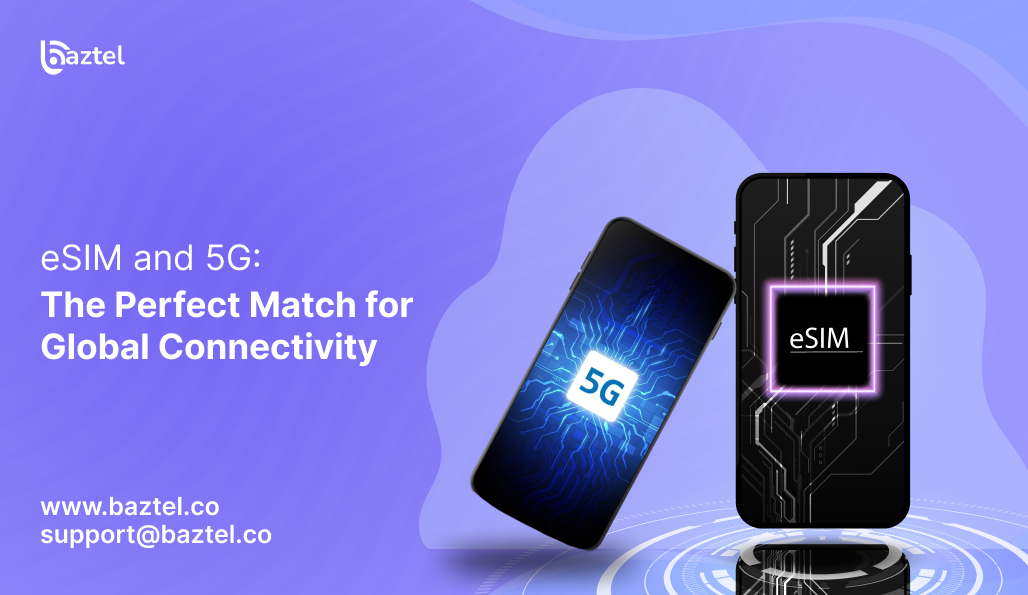The way we use mobile networks is changing fast. With 5G rolling out globally and eSIM replacing physical SIM cards, the future of connectivity looks smarter. You no longer need to insert a SIM or stand in a queue. Just scan, activate, and connect. And with 5G, your internet works faster, even in crowded areas. Together, eSIM and 5G create a system that’s flexible, fast, and ready for global use. Whether you’re traveling abroad, working remotely, or managing IoT devices, this combo makes everything smoother. In this blog, we’ll break down how eSIM with 5G is changing the game and what it means for the future.
What is eSIM and 5G Technology?
Before we understand how eSIM and 5G work together, it’s important to know what each one means. An eSIM is a digital SIM already built into your device. It lets you activate mobile plans without inserting a physical SIM card. You just scan a QR code or follow simple steps in phone settings. On the other hand, 5G is the next level of mobile internet. It brings faster speed, better coverage, and strong signal seven in crowded areas. While eSIM simplifies how you connect to a network, 5G makes sure that connection stays fast and stable. When these two come together, they make your phone or any smart device smarter, faster, and future-ready.
What is an eSIM and How It Works
An eSIM is a small chip that’s already inside your phone. You don’t need to insert anything. Just scan a QR code, and your mobile plan gets activated. No shop visits. No SIM trays. You can switch plans or use two numbers at once like one for travel, one for daily use. It’s all digital, and that makes life easier. eSIM is built for people who travel, use multiple networks, or just want fewer hassles with mobile data.
Key Benefits of Using eSIM Over Physical SIMs
No more losing SIM cards or carrying tiny ejector pins. eSIM stays in your phone, and all your mobile settings stay online. You can switch networks on the go, try travel data plans, or even use multiple numbers without opening your phone. For businesses, it saves time on managing large fleets of devices. For users, it removes the usual pain points of slow activation, SIM swap delays, or network lock-ins.
What Makes 5G Different from 4G and LTE
5G means faster internet. But it’s not just about speed it also handles more devices at once. You get smoother video calls, zero buffering while streaming, and faster uploads. Whether you’re working remotely or playing games, 5G keeps everything stable. It’s a big upgrade over 4G, especially in crowded places like malls, stations, or stadiums where older networks slow down.
Why eSIM and 5G Are Considered Future-Ready
eSIM gives you freedom to change plans without touching your phone. 5G gives you lightning-fast speeds. Together, they remove most of the common issues users face: slow setup, poor signals, or data dropouts. As more devices shift to smart connectivity, this combo helps people stay online, no matter where they are. From regular users to big businesses, eSIM and 5G are made for what’s coming next in the tech world.
Why eSIM and 5G are a Game-Changer Together
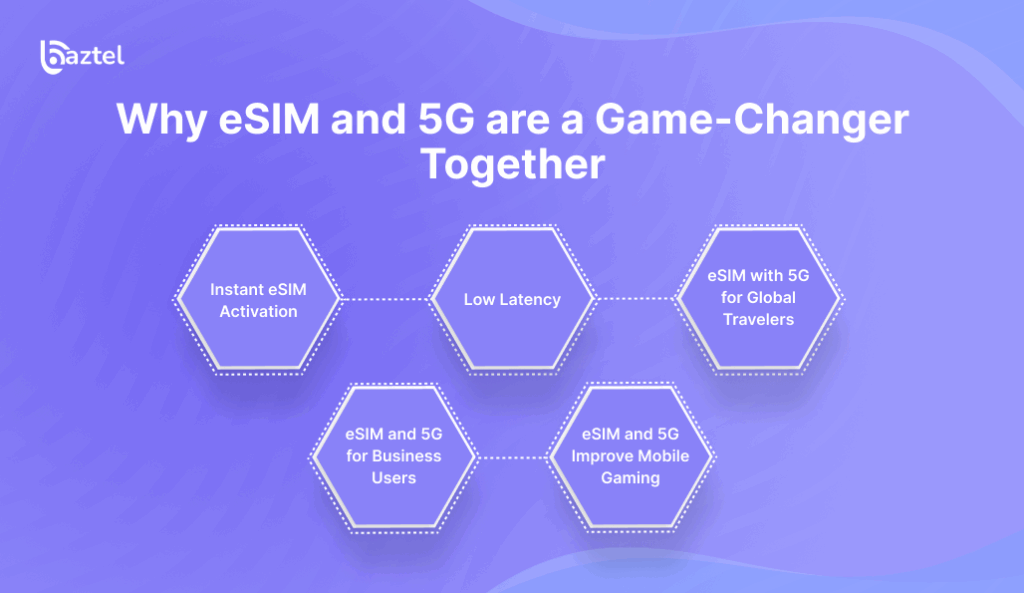
On their own, both eSIM and 5G offer major benefits. But when used together, they create a faster, smarter, and more flexible way to stay connected. With eSIM, you can switch data plans without touching your phone. With 5G, you get better speed, lower delay, and stronger signal even in crowded areas. Together, they remove the usual issues like SIM swaps, roaming charges, or slow networks. This mix is perfect for frequent travelers, remote workers, gamers, and businesses that rely on stable data. From instant activation to smooth mobile gaming, eSIM with 5G is changing how people connect around the world.
Instant eSIM Activation on 5G Devices
With 5G phones supporting eSIM, you can skip the physical SIM card completely. Just scan, activate, and go online in minutes. This is a huge benefit for people who travel or shift between networks. No queues, no forms, no delays. Platforms like Baztel offer QR-based eSIM activation that works smoothly with 5G-enabled phones. The process is simple, remote, and works before you even land in a new country.
Low Latency: Why It Matters for Mobile Users
5G reduces latency to almost zero. This means apps respond faster, video calls don’t lag, and even online games work better. When combined with eSIM plans for travel, it offers smooth mobile experiences across borders. Whether you’re in a crowded city or remote village, this combo gives you high-speed internet with reliable performance with no SIM swap needed.
eSIM with 5G for Global Travelers
This is where it really shines. Imagine you land in a new country, and your 5G phone connects instantly using an international eSIM plan. No hunting for local SIM shops. No waiting in queues. You get 5G speed for maps, calls, and hotel bookings right after landing. Travelers now prefer eSIM with 5G for its speed, security, and ease of use.
eSIM and 5G for Business Users
Business users switch between cities and countries often. With eSIM and 5G, they don’t need to change SIMs or carry multiple phones. Just use one device with dual eSIM profiles for office and travel. You can activate a local data plan instantly, get 5G speeds, and stay connected without extra hardware. Many enterprises using IoT also rely on this setup for better efficiency.
How eSIM and 5G Improve Mobile Gaming
Online games need fast response time and uninterrupted internet. That’s where 5G helps. And with eSIM, you can activate a new data pack in secondsno need to go offline. For gamers who travel or stream, using eSIM in compatible phones means they never lose connection. The setup is smoother, and games load faster even while moving across networks or countries.
The Future of Connectivity with eSIM in the 5G Era
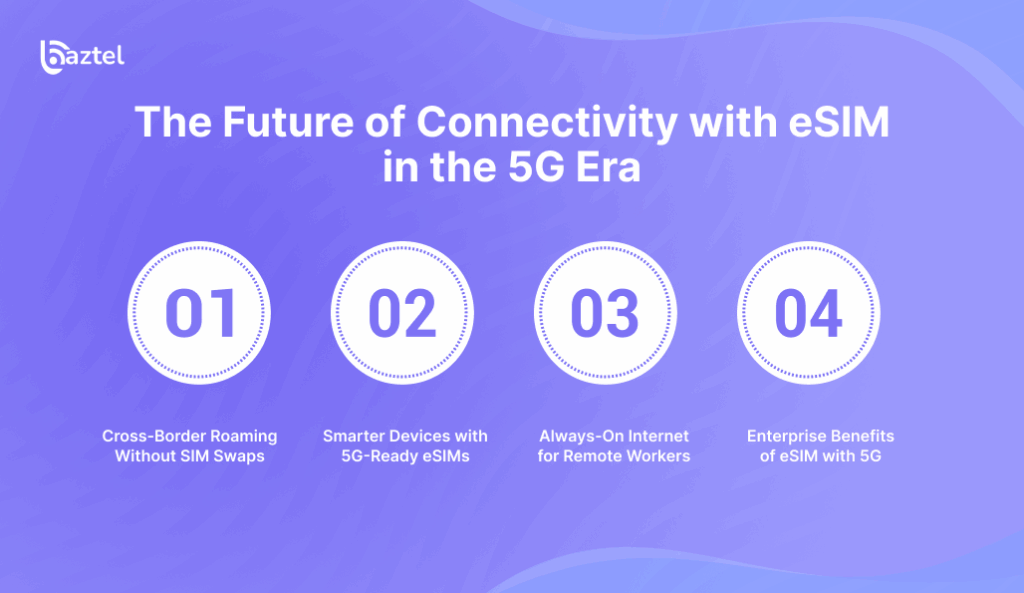
Technology is moving fast, and mobile connectivity is going through big changes. With eSIM becoming common and 5G expanding globally, the way we connect is now faster, smarter, and more flexible. You no longer need Wi-Fi or SIM shops, just activate a plan and go online. From travel to remote work, this setup works anywhere. Devices are also becoming smarterwatches, tablets, even cars now run on eSIM with 5G. This shift is not just for tech loversit’s for everyday users too. The eSIM technology future is all about staying connected, without cables, cards, or confusion. And as more smart devices adopt this, the change will only grow bigger.
Cross-Border Roaming Without SIM Swaps
With eSIM, you don’t need to remove or replace SIMs when you enter a new country. Just activate a local data pack online and connect instantly. Combine that with 5G, and you get fast internet even before leaving the airport. It’s ideal for international travel. Platforms like Baztel let you skip paperwork and connect across borders in seconds. This cross-border ease is shaping how people move and work in a global world.
Smarter Devices with 5G-Ready eSIMs
Phones aren’t the only smart devices anymore. Laptops, tablets, smart watches, even cars are now 5G-enabled and use eSIM. It means your device can stay connected without Wi-Fi or tethering. From students to field workers, eSIM in 5G-ready devices allows people to work, learn, or track things remotely. This growth in connected devices is a clear sign of where technology is heading.
Always-On Internet for Remote Workers
Work-from-anywhere is the new normal. And nothing supports it better than eSIM with 5G. You don’t need to depend on hotel Wi-Fi or public networks. Just use an eSIM plan with 5G and enjoy a strong, private internet wherever you go. Remote workers now rely on this setup to join Zoom calls, upload files, or run cloud apps smoothly without delays or dropouts.
Enterprise Benefits of eSIM with 5G
For companies, switching to eSIM simplifies bulk device management. You can activate or change employee plans remotely. Add 5G to that, and your teams get instant access to fast, secure data even in field locations. Industries like logistics, transport, and smart infrastructure are moving to this model. With remote provisioning, there’s no need for physical handling, which saves cost and effort at scale.
How eSIM Will Support Next-Gen Smart Devices
As tech moves forward, devices are getting smaller and more connected. Future gadgets like wearables, smart glasses, drones, and health trackers won’t have space for SIM trays. That’s where eSIM fits in. And when paired with 5G, these devices work in real time. Whether it’s for tracking health or monitoring delivery fleets, the eSIM technology’s future lies in making devices truly independent, always connected, and ready for what’s next.
eSIM and 5G in IoT and M2M Devices
IoT and M2M devices are becoming common in homes, hospitals, factories, and farms. These devices need stable internet to work properly even in places where Wi-Fi isn’t available. That’s where eSIM and 5G come in. eSIM removes the need for physical SIM cards, while 5G ensures fast, real-time data transfer. Together, they help smart devices stay connected, even while moving across borders. From connected cars to health monitors, this setup is now key to smooth automation. Our full guide on eSIM for IoT explains how businesses and everyday users can benefit from this growing technology shift.
Why IoT Needs eSIM with 5G
IoT devices are everywhere from GPS trackers to smart fridges. These machines need constant internet, even when there’s no Wi-Fi nearby. That’s where eSIM with 5G helps. It offers built-in network access and faster speeds, which keeps everything online in real time. No SIM tray, no manual setup. This combo allows companies to scale devices globally. Our detailed guide on eSIM for IoT explains how it’s shaping smart industries.
eSIM in Smart Home Devices
Smart lights, cameras, speakers, and doorbells are becoming common in Indian homes. Most run on Wi-Fi, but when that fails, eSIM keeps them connected using 5G. You can monitor security cameras or control devices from anywhere, without relying on broadband. Home automation brands are now offering eSIM-compatible options, making things easier for homeowners who want 24×7 remote access.
eSIM with 5G in Connected Cars
Cars with 5G and eSIM can do more than just navigation. They stream music, offer roadside assistance, update maps in real time, and even monitor engine health. With built-in connectivity, there’s no need to insert a SIM card. Car brands are using this tech to give drivers live traffic data, accident alerts, and over-the-air updates. Fleet companies also prefer it to track vehicles without external hardware.
eSIM and 5G in Healthcare Devices
Medical wearables and patient monitors need a stable network to send health data in real time. With eSIM and 5G, devices like glucose monitors, heart trackers, and emergency alerts stay connected even in remote areas. Doctors can monitor patients remotely, and families get instant health updates. In the future, more health-tech devices will come with built-in eSIM to cut delays and improve care.
Logistics & Supply Chain Use Cases
From trucks to shipping containers, logistics firms are adding smart sensors to track goods. These devices need round-the-clock internet even while moving across countries. eSIM ensures they stay connected, while 5G offers the speed to send live location, temperature, or damage alerts. It also removes the headache of switching SIM cards while crossing borders. Businesses using smart tracking save both time and losses.
Agriculture and Smart Farming with eSIM
Farmers are using smart tools to monitor soil, crops, water use, and weather. These tools often work in rural areas where the network is patchy. With 5G and eSIM, even remote sensors can send updates in real time. No need for manual checks or waiting days for reports. Farmers can get alerts about low water or pests instantly. Connected farming is now possible without Wi-Fi or SIM swaps.
No More Airport SIM Queues for Travelers
You land in a new country and need data fast but buying a SIM at the airport takes time, costs more, and needs ID proof. With eSIM for international travel, you can skip all this. Just scan, activate, and start using 5G internet within minutes of landing. It’s a huge relief for tourists, remote workers, and digital nomads who want to stay connected from Day 1.
How eSIM and 5G Will Impact Consumers Worldwide
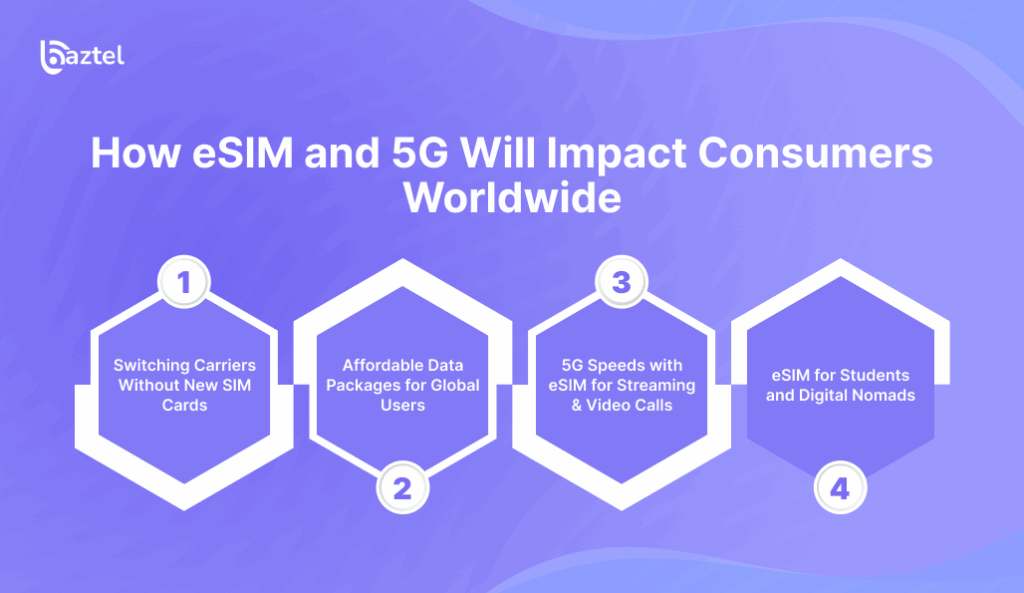
eSIM and 5G are changing how people use mobile networks every day. You can now skip physical SIM cards, avoid high roaming fees, and activate fast data plans with just a QR scan. Whether you’re a student, a traveler, or someone working remotely, this combo offers more speed and freedom. You can switch carriers, buy local data, or run apps without worrying about weak signals. Many now use eSIM for international travel to stay connected on the move. With 5G in the picture, your phone stays fast, stable, and always ready wherever you go.
Switching Carriers Without New SIM Cards
Changing your mobile plan no longer means changing a SIM. With eSIM, you can switch carriers from your phone settings to tools or shop visits. Add 5G to that, and your connection stays fast and stable. People tired of poor signals or limited data now switch to better plans instantly. Baztel users often do this while comparing network coverage in different cities.
Affordable Data Packages for Global Users
Roaming charges can be brutal. But eSIM lets you buy local plans while you travel, at local rates. When combined with 5G, even low-cost plans offer solid speed and coverage. You can watch videos, make calls, or work online without burning your budget. Many travelers to Europe now rely on eSIM-only data packs to save money and avoid roaming headaches.
5G Speeds with eSIM for Streaming & Video Calls
Want to stream movies, attend Zoom meetings, or video call family while abroad? You need speed. 5G gives that. And when paired with eSIM, you can activate a fast data pack in seconds. No waiting, no disconnection. Many frequent flyers now buy eSIMs online before flying, just to keep their entertainment and work going smoothly.
eSIM for Students and Digital Nomads
Students studying abroad and freelancers working remotely often need budget-friendly data with strong signals. Carrying multiple SIMs or paying roaming bills is not an option. eSIM gives them freedom to pick and switch plans based on where they are. With 5G, video lectures, assignments, and cloud tools work without lag. Our guide on device compatibility helps students pick the right phones that support eSIM and 5G together.
Challenges in Adopting eSIM with 5G
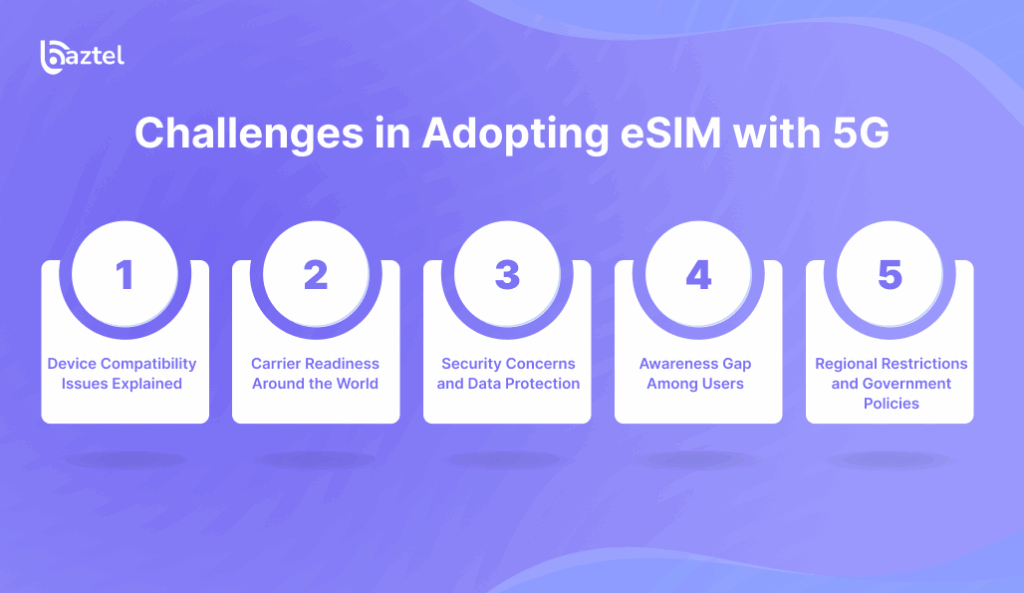
While the idea of using eSIM with 5G sounds great, it’s not fully smooth yet. Not all phones support both technologies, and some telecom operators still don’t offer eSIM plans. Many users don’t know how to activate it, or if their device is even compatible. There are also safety concerns about QR codes and fake eSIM sellers. In some regions, strict rules make it harder to activate eSIM freely. Our guide on phone compatibility and eSIM activation can help users avoid these common issues before making the switch.
Device Compatibility Issues Explained
Not every phone supports eSIM, and not all support 5G. To use both, your device must have the right hardware and software. Many older or budget phones miss out. Before buying a plan, check if your phone supports eSIM with 5G. This ensures you don’t face errors during activation or slow speeds during use.
Carrier Readiness Around the World
While eSIM is growing, not all telecom operators offer support. Some still rely on physical SIMs, and others don’t allow easy switching between plans. In some countries, even 5G coverage is limited. It’s important to pick a provider like Baztel that supports both technologies across multiple destinations and networks.
Security Concerns and Data Protection
Any digital system comes with risks. People often ask what if my eSIM is hacked or my phone is cloned? While eSIM is safe when activated through trusted sources, public QR codes or unknown sellers can be risky. Using verified travel eSIM providers and keeping your device updated can reduce most of these issues.
Awareness Gap Among Users
Many users still don’t know what eSIM is or how to use it. Even people with supported phones stick to physical SIMs because they’re not aware of the benefits. That’s why we created simple guides like how to activate eSIM and compatibility checks, so anyone/even first-time users can make the switch without confusion.
Regional Restrictions and Government Policies
In some countries, eSIMs need identity verification or local address proof. Some governments have strict telecom rules that limit how freely users can activate eSIMs. Even 5G availability depends on local approvals. So before travel, it’s smart to read our country-specific eSIM blogs and pick plans that meet both legal and technical requirements.
eSIM Technology Future: Predictions for the Next Decade
The next 10 years will bring major changes in how we connect to mobile networks. eSIM is already replacing physical SIMs, and 5G is just the start. With faster internet, remote access, and device automation, we’re heading toward a world where your phone, car, watch, even your homestays are connected without wires or SIM cards. From smart cities to AI gadgets, the eSIM technology future looks strong. Our future of eSIM blog already shows how this shift has begun. What’s coming next? Smaller devices, faster switches, and global plans that work across borders in seconds.
How eSIM and 5G Will Lead to 6G
As 5G becomes common, tech companies are already working on 6G. eSIM will play a big role here. It removes the limits of physical SIMs, making faster switching and global access possible. In future, devices will auto-connect to the best networks without manual input. If you’re already using eSIM with 5G, you’re halfway ready for what’s next.
Will Physical SIM Cards Disappear?
Yes, slowly. More brands are removing SIM slots from new phones, starting with premium models. With eSIM built-in, there’s no need for plastic cards anymore. This also makes phones slimmer and waterproof. Like memory cards and headphone jacks, physical SIMs are on their way out. Travelers using eSIMs have already made the switch and soon, most users will follow.
Role of eSIM in Smart Cities Development
Smart cities need thousands of connected devices: sensors, traffic lights, electric meters, public Wi-Fi. All of them need a stable, secure internet. eSIM helps here by allowing remote control and easy activation. With 5G, these devices can send data in real time. Our blog on IoT devices explains how this setup is already being used in transport, waste, and public safety systems.
eSIM in AI-Powered Devices and Robotics
From warehouse robots to smart speakers, AI devices work better with stable networks. eSIM and 5G ensure they don’t lose signal or lag during tasks. With no physical SIM slots, future AI tools will be smaller, lighter, and smarter. They’ll connect instantly, switch networks based on speed, and be managed remotely. The rise of eSIM technology in the future isn’t limited to phonesit’s about powering next-gen machines too.
Future of Global Telecom with eSIM
Telecom companies are shifting from local service providers to global platforms. eSIM supports this move by removing physical boundaries. A single plan can work across countries, letting users roam freely without charges. With the help of remote eSIM provisioning, telecoms can onboard users in minutesno shops, no paperwork. This is the direction global telecom is now moving towards.
Conclusion
The journey of mobile connectivity is moving toward flexibility and speed. eSIM removes the old habit of swapping SIM cards, while 5G delivers faster internet with stable performance. Together, they make life easier for travelers, students, remote workers, and businesses. From instant activation to smooth video calls, this mix is already solving real problems. The best part—it’s not limited to phones. Cars, smartwatches, health trackers, and IoT devices are also shifting to this model. Our guide on international eSIM plans shows how users are already making the switch. The future of connectivity is clear: eSIM and 5G will lead the way, giving us global, always-on, and hassle-free access.
Frequently Asked Questions
1. Does eSIM work with 5G?
Yes, eSIM works with 5G if your device supports both features. Many new phones come with eSIM and 5G support together. You just need to check device compatibility before buying a plan.
2. Is eSIM faster than a physical SIM on 5G?
Speed depends on the network, not the SIM. With 5G, both physical SIM and eSIM give the same internet speed. The main difference is that eSIM is easier to activate and manage compared to a physical SIM.
3. Can I use eSIM for international travel with 5G?
Yes. Many travelers now buy eSIM for international travel before their flight. Once they land, the plan activates instantly, and they get 5G speeds without waiting in SIM card queues.
4. Are there any risks in using eSIM with 5G?
eSIM is safe if you buy from trusted providers. Risks like fake QR codes or unverified sellers can cause problems. Always use official platforms like Baztel or verified carriers for secure activation.
5. Will physical SIM cards disappear in the future?
Yes, slowly. Many premium phones are already launching without SIM slots. With eSIM and 5G growing, physical SIM cards will become rare in the next few years, just like memory cards and headphone jacks in older phones.
Blog Author
Peter
Peter started BazTel.co to make mobile internet easier for travellers. He noticed how tough it was to find good network options while visiting new countries. That’s when he built BazTel — a place where anyone can buy eSIMs online without confusion or long steps. He believes tech should be simple and useful, not complicated. When he’s free, he likes to travel, test BazTel himself, and keep improving it based on real user problems.

 Botswana
Botswana Zambia
Zambia Congo
Congo Colombia
Colombia China mainland
China mainland Chile
Chile Chad
Chad Central African Republic
Central African Republic Canada
Canada Cameroon
Cameroon Cambodia
Cambodia Burkina Faso
Burkina Faso Bulgaria
Bulgaria Brunei Darussalam
Brunei Darussalam Brazil
Brazil Aland Islands
Aland Islands Bosnia and Herzegovina
Bosnia and Herzegovina Bolivia
Bolivia Belgium
Belgium Belarus
Belarus Bangladesh
Bangladesh Bahrain
Bahrain Azerbaijan
Azerbaijan Austria
Austria Australia
Australia Armenia
Armenia Argentina
Argentina Algeria
Algeria